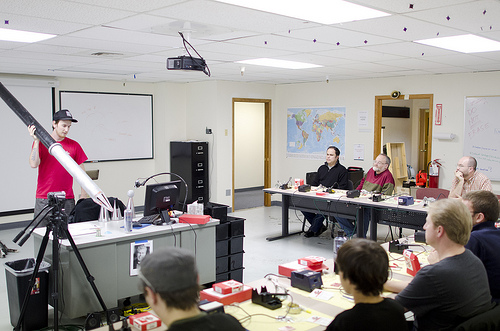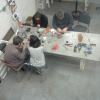I'm not entirely sure how we're going to use these analogies, but I definitely got a lot of ideas reading through them about different ideas I could incorporate into the classroom. My apologies if your analogy was overlooked, I grabbed all the comments I saw on each blog the day after the content went live. It is my hope that your contributions will be useful to educators in the future. We got your input and, in true SparkFun fashion, we're going to share them, make jokes about them and just generally expound at high volume. There were many I've never seen before and physical computing is such a young field that you may see your analogy become a cornerstone in SparkFun's workshops down the line.... If that happens we fully encourage you to make some noise and take credit where credit is due! (I'll give you credit in written work but I can't vouch for off the cuff citations.) Even though Open Source Education isn't officially a branch of the Open Source family yet, we'll keep doing it with our workshops and blog posts like this until someone decides to officially include it in the family.
Before I list the winners and their analogies or metaphors I'd like to continue the discussion of Open Source Education. These days we're seeing MOOCS, all sorts of cool educational freeware, free workshops, free course content in a variety of formats, of course things like TED Talks and people just generally sharing knowledge on YouTube for free. I've even heard about people playing with the idea of a flash mob style hackathon in true guerilla educator fashion. What are some of the more obscure or cool ways you, or people you know, are expanding the world of Open Source Education?
So without further rambling here are the winners and their input from the RedBoard giveaway:
Raighteye –
My science teacher always explained the movement of electricity with trolls. All trolls have a little bit of electric energy, and their job is to deliver that energy.
Voltage: U
The amount of trolls that run by every second.
Amps: I
The amount of energy that the trolls are carrying at one time.
Resistance: ohm
LARGE diameter thread is when the trolls can walk next to each other on that road, the wider the road is the more trolls can walk next to each other. They can deliver more energy at a time. (low resistance) SMALL diameter thread is when trolls are on a small road and they have to walk behind each other. They have to deliver the energy one by one. (high resistance)
SOFT sandy roads are slower because it's harder to run on (high resistance/ by material). HARD roads are fast, because you can run on them faster (low resistance/ by material).
If there are too many trolls on a high-resistance road, then they will start to fight each other, and things will heat up. It could even be so that they crash into each other and damage the road.
Resistors:
Resistors are when the road narrows to make sure that the trolls won’t fight each other and cause crashes. Or to make sure that they don’t deliver too much energy at one time.
You can explain almost everything electric with trolls XD jolts (trolls jumping over a ravine) path of least resistance (they race each other and when one finds the fastest route they al take that route).
Trolls are my go to explanation because its really easy to imagine trolls doing that kind of stuff.
The Kitty –
As DC current goes through an inductance like a motor or other coiled wire, it builds up magnetic flux, a form of potential energy, which will collapse the opposite way when the DC current is removed. The analogy is lifting a weight creates the potential energy between the ground and the weight which, when you release your hand, causes the weight to drop back to the floor. To ensure this stored energy does not hurt your electronics in undesirable ways, adding a diode across the coil, allowing the collapsing flux energy to go back to the coil and not your electronics, is controlling the fall of the weight, rather than it going in a crazy direction like landing on your foot (ouch!).
A diode is like a water valve that allows liquid to flow in one direction but prevents it from flowing back the other direction. Much like one that may be found on a sewage system to allow sewage to leave a building but not for sewage to back up from the sewer back into the building (ewww!).
BeerCannon –
We often read or are told that “under the hood,” computers only understand zeros and ones. Whether you’re talking about a document, a picture, a video, a program...they’re all represented by zeros and ones. That’s pretty arcane to a novice, so I try to get this point across: it’s the contextual interpretation of those zeros and ones. Without some agreed-upon rules about how to group and interpret those zeros and ones, it would just be a stream of digits. But we (and the computers) have to take a step back and look at those digits from a different perspective and apply rules to see meaning. A classic example is “Paul Revere’s Ride,” where he told someone to hang lanterns in the church belfry if the British were coming. He said to hang “one if by land, two if by sea.” Without that rule/context, an observer would just see lanterns. But with the knowledge of the rule by which the information is to be interpreted, those lanterns convey information. That is how computers can use something as simple as zeros and ones to convey many different kinds of information...by applying different rules for the interpretation of those digits.
Restifo –
My dad, who was an EW in the Navy, taught me the conceptual idea of how a transistor works as a switch using a fork, a knife, and a spoon. Obtain a fork, knife and spoon. Make the knife the collector. Make the base the spoon. Make the fork the emitter. Lay them out just like a transistor symbol but don’t connect them.
When no voltage is applied, current can’t “jump” from the knife to the fork. When you apply a voltage, you “nudge” the spoon in.current can now jump from the knife (collector) to fork (emitter). This is obviously for NPN. Remove the voltage, pull away the spoon. It also helps you remember whether you need a high or low voltage. You can reverse the concept and “pull” the spoon for a PNP. Think “nudge” (“n”) for NPN and “pull” (“p”) for PNP.
I’ve found it an easy way to abstractly think about a transistor before learning about PN junctions/holes/electrons and such.
Chienline –
Let’s start from the very basic blink sketch:
int led = 13;
void setup() {
pinMode(led, OUTPUT);
}
void loop() {
digitalWrite(led, HIGH);
delay(1000);
digitalWrite(led, LOW);
delay(1000);
}
Analogy: Wood Chopper.
(describe per line)
Joe = ‘the man lives on 24th Banana Ave’;
preparation(){
equipment = an axe;
}
do_again_and_again(){ … [won’t stop until loosing power]
raise the axe up;
take breath for one second;
chop the wood;
release breath for one second;
}
This analogy tries to describe how we initialize a constant into a variable at the very beginning for further use, so variable should be something easy to remember rather than remembering the constant itself. When people say ‘Joe,’ we got his image instantly rather than ‘the man lives on 24th Banana Ave.’
The setup() block which is preparing things we need and done only once.
The loop() block which is done again and again until the Arduino board is unplugged and loosing power :-)
It also describes delay() function, where Arduino does something (execute the line), the man also does something (breathing), but we cannot see the action, that is delay(), wait for some milliseconds.
Ford Anglia –
An LED (Light Emitting Diode) is a special semiconductor device that takes electrical power and converts it to light (and some heat). The LED is like a balloon. Without any air (no electrical current flows in) it doesn’t look like a balloon (the LED is dark). With the right pressure (correct electrical current) the balloon has a nice shape (the LED is bright). Too much pressure (too much current flowing) and the balloon bursts (Your LED goes dark forever…)! The balloon pressure can be regulated by holding the balloon in your hands, and only blowing enough to inflate it safely. The LED requires a “ballast resistor” – another electronic component that limits the current to a safe flow.
Imagine a wine glass held in one’s hand, and letting it drop to the table. Holding the wine glass higher from the table would make a louder noise when the wine glass is let go and it lands. If the wine glass is dropped from a greater height it may break when hitting the table. The wine glass has a maximum safe height rating, telling us not to drop it too far. Electronic components have a maximum rating, measured in volts, where they work safely. Operating a low-rated component from a voltage that is too high will break it!
A ship’s Engine Order Telegraph (EOT) was used in the olden days to allow the capt’n to instruct the engine room crew. Simple commands; “STOP”, “FULL AHEAD”, etc. were sent by moving a handle to the desired position on the dial in the bridge, which caused a pointer in the engine room to follow on its own dial and then ring a bell. The engine room acknowledges the new command by moving their handle to match the new command, which in turn caused the dial to move and a bell to ring on the bridge. Both dials must match, confirming the order was received and will be executed by the engine room. In electronics we call that process a “handshake” – Electronic circuits at the sending end of a cable makes messages as electrical pulses, the receiving end answers back with an acknowledge. The popular eye-to-see (or Two Wire Interface as it is called by Atmel) is used in a bunch of SFE products like this one. It sends an ACK (Acknowledge) bit after each byte (eight bits) of data. If the message is lost or not understood, or sent to the wrong address, the sender will get back a NACK (No ACK). This makes the simple I2C two wire bus very robust and reliable.
K Watts –
My brother-in-law is a mechanic so when we talk electronics I try to put things in automotive terms. A few examples: decoupling capacitors on a power supply are like shocks that smooth out a rough “voltage road.” A diode after a solar panel prevents electrons from flowing in the wrong direction, just like the check valve between the fuel tank and the engine.
Member # 470975 –
For the younger learner who might not understand the difference between voltage and amperage and how the battery provides them.
Imagine you are eating supper, the cook (the battery) chooses what is for supper (the voltage), you and every other person at the table (the devices) choose how much you will eat (the amperage). The total amperage of the circuit (everyone listed above) is the total amount of food eaten, but at the end of the day it was still the same type of meal because voltage was set by the battery.
This could probably also be extended to voltage drops… if someone doesn’t like a portion of the meal
Member # 230204 –
A Device’s RAM is like a garage full of boxes. Each box is a variable, the contents of the box are the data stored in the variable. Arrays are the stacks of boxes each holding related data. Pointers tell you where to find the boxes. Many boxes contain garbage (garbage values) until you initialise the variable (box) and put something meaningfull in it. An error (e.g. stack overflow) occurs when you try to put a box (variable) outside the garage (maybe in your neighbor's garage). Problems also occur if you try to put something bigger than the box in the box (e.g. putting a 64 bit value in a 32 bit box) or put the wrong shape item (data type) in the box (e.g. putting a char into an int).
EdWilson1989 –
I was asked once to explain the function of basic electronic components in a way that someone without any knowledge of engineering or maths would understand. The hydraulic analogy is good but requires understanding of pressures.
I went with Traffic to explain it. Diodes are one way streets, Transistors are traffic lights, Resistors are traffic calming measures (You’ll have to be in the UK to understand that one). At a more detailed level the cars can represent charge (current) with the number of people in each car being the energy (volts).
This worked well for me. I understand that under great scrutiny it collapse for the explanation of basic principles it is sound.
GCF –
I taught high school physics, so teaching why resistors and capacitors do what they do and why they do it always came down to analogies. The students always enjoyed relating a parallel plate capacitor to a junior high dance floor. All the girls (positive charges since girls are cheery) and boys (negative charges, obviously), line up on opposite sides of the dance floor. However, they never actually cross the dance floor, since they are in junior high and are afraid of each other. If you make the dance floor wider, then more boys and girls can line up, which gives you more capacity for the kids - this is an increase in capacitance. On the other hand, if you make the dance floor really wide, the boys and girls are less interested in each other and don’t want to line up anymore - this is a decrease in capacitance.
This explains the general equation that C=(epsilon)A/d. The width of the dance floor is the area of the capacitor. As the area increases, the capacitance increases. The distance between the boys and girls is like the distance between the plates of a capacitor. As the distance increases, the capacitance decreases.
If you want to get really crazy, you can explain that the permittivity of the material or dielectric (epsilon) is similar to whether that are obstacles that block the view of the girls and boys on the dance floor. The less their vision is permitted, the lower the epsilon value, and the lower the capacitance. The higher the permittivity, the higher the capacitance.
Snobbotics –
Current, Voltage, Resistance, Inductance, and Capacitance
Electrons are like cars, traveling along a road called a conductor. The road starts at a car dealership and ends at a recycling center. Good roads/conductors have many lanes to travel on. Each car/electron perfectly tailgates the electron in front of them, and there is no extra space on each lane of the road. Current is the rate at which cars pass a given mile-marker with respect to time. Because every electron/car is tailgating the next, all electrons move at the same speed, at the same time (unless in a dealership). The quality of the road (ice, dirt, gravel, pavement) will determine how easy it is for cars to drive on it, and is called resistance. Voltage is the difference between the number of cars at the dealership and the number of cars at the recycling center. If there are more cars at the dealership than there are at the recycling center, cars will drive from the dealership, through your circuit (hopefully) and into the recycling center. If there’s a short (a direct connection between the dealership and the recycling center), the new cars at the dealership will drive right into the car smasher! The ratio of voltage to resistance determines the current on the road. If there are tons of Batmobiles and F350s on the lot and the Recycling center is empty, there’s gonna be a current! Lots of cars to sell means more current. Terrible roads means less current. The speed of the electrons is determined by the wind speed and direction near the road. Wind conditions are called inductance. The current of the cars will generate its own wind force called flux, which will allow the cars to speed up, since the wind will travel in the same direction. If the resistance of the road increases or the voltage decreases, the moving air/flux will help propel the cars forward, resisting a change in current. Lastly, there are multiple car dealership-middle-men along the way to the recycling center. Cars sold at the main dealership are sold, drive, and then traded in and bought from the mini dealerships along the way until reaching the recycling center. Each mini dealership has an input and an output, and can hold a few cars (not as many as the main dealership). If the voltage of the main dealership changes and as a result, sells more cars, the mini dealerships have to buy those cars before they can sell more as well. This delay to change in voltage is called capacitance.
Passive filters: In a high pass filter, the capacitor takes the “high road” In a low pass filter, the capacitor takes the “low road”
Pdasilva18 –
Not sure if the reasoning is actually true, but when making PCB traces, I always remember to use limited amount of 90 degrees because the electron flow is limited and can cause problems, much like on a race track. A race car driver would find it harder to take a sharp 90 degree turn at high speeds then if the turn was rounded or if the turn was more 45 straight 45.
trying to interact with each other. Without a common language, the two people will not be able to interact, but once both people share a common language, information can be shared. Much like a programmer communicating to a piece of hardware what its job is or two pieces of hardware communicating amongst each other
I always compare programming a microcontroller to giving someone who has never made a peanut butter sandwich instructions on how to make one. If your instructions arn’t clear, then the results may vary. This is better done while ACTUALLY trying to make a peanut butter sandwich using only the instructions: 1. Spread peanut butter on one slice of bread. 2. Place the remaining slice of bread on top of the peanut butter. 3. Eat and enjoy. When trying to spread the peanut butter, use your hand instead of a knife claiming you were never told to use a knife. You can play around with it claiming you don’t know how to open the jar or handle a knife, etc. Basically I used this to understand that every instruction has a precise purpose and the microcontroller should know exactly how to do something the way I intended it to by the time I am done writing its program.
A program not having a condition statement out of a while loop is like a ferris wheel not stopping to let people out. You always need to program (build) a way out of the while loop (a way off of the ferris wheel).
Kaius –
I always compare SPI to a clothes line with pulleys on either end. If you (the master) want to get the clothes (data) at the other end of the line (think slave), you need to move the line yourself (flipping the clock). This will also cause any clothes on your end to be move to other end of the clothes line.
Flecko –
Old trick taught to me many years ago regarding Ohm’s Law. It pings my memory every time.
V=IR
V is the Vulture I is the Indian R is the Rabbit To remember how to solve for each, remember that:
The Vulture sees the Indian next to the Rabbit ( V = IR )
The Indian sees the Vulture hovering over the Rabbit ( I = V/R, or I = V (over) R )
The Rabbit sees the Vulture flying over the Indian ( R = V/I, or R = V (over) I )
For most people this seems incredibly easy and is almost unnecessary. But depending on the age you teach this to, it can stick while still teaching basic math. I know this worked well when I was younger, and has stuck with me since. Maybe it will help someone else!
Tammo –
As I come from Germany we once had a professor in electronics who teached us the distribution of the different types of power an induction motor uses with the analogy to a well-made german beer.
Than in Germany that is approx. 1/6 of froth (or foam, don’t know the exact translation) - the REACTIVE POWER (not very useful, but it won’t work without it)
The remaining 5/6 is beer - the EFFECTIVE/REAL POWER (does the whole work in the motor)
And after all both together is - the APPARENT POWER (the power for which you pay)
nonInjureNinja –
I use this one for talking about a computer in general and the function of its components. A computer is analogous to a box of stuff in the garage. Getting a hard drive/ flash memory with more capacity for data is like getting a bigger box so you can store more stuff in it. Getting a faster processor that can manipulate data at a greater rate is like being able to search through the stuff in the box faster. Getting more RAM capacity is like being able to hold more of the stuff you need in your hands while you work on it rather than having to dig though the box and get one piece to use at a time. I guess the power supply is like lunch, so you feel like going into the garage and looking through boxes. Turned out to be simile I think.
Jess –
It sounds like the water piping analogy for electricity is very popular. Going along with that analogy, my favorite for a capacitor has been the spring loaded piston or spring loaded accumulator. Most people can see as the cylinder fills, spring gets tighter and it’s resistance to filling increases; or in other words as the cylinder fills up, the water also flows in more slowly due to the spring getting stiffer. You can also explain you need a spring rated for the pressure or voltage as to not bottom out the cylinder or capacitor and damage it. Hence why your capacitor needs to be rated for the voltage. You can also explain ESR with the above describing a plate with a hole in it located at the inlet for a resistor. I think someone had already mentioned it, but I’ve had good success explaining resistors as a plate with a hole in it, and varying the resistance with the size of the hole drilled in the plate. Obviously the bigger the hole, the less resistance.
ThunderDad –
I taught a small class of elementary school students recently. I briefly explained atoms, and told them some atoms had so many electrons they didn’t mind sharing. We all ran around chairs, orbiting. Then, I told them how a battery’s voltage pushes electrons from one atom to the next, pulling kids from one chair orbit to another chair. We made lemon batteries, designed a simple LED circuit, and built it. They could accept that current was how many electrons were passing along the atoms (copper wire), and the resistors let fewer electrons pass. They could even accept the acid in the juice made the metals more willing to share their electrons. It was very interactive, and they really caught on.
Deltanyne –
My dad was a sixth grade science teacher and his way of introducing circuits to kids was to have them use a rope and pulleys. For explaining how charge flows and how electrical energy works use pulleys and rope, with the rope ends just held in a loop together with tape or something. This shows how the electric charges in a metal can be forced to flow in a circle. You can also use the pulleys to demonstrate generators and motors depending on how you drive them i.e. with your hand or with the rope. You can demonstrate an open circuit by disconnecting the ends or illustrate an electric heater or resistor by letting the moving rope rub against your fingers so your fingers get hot. Or, to illustrate Alternating Current, turn one wheel back and forth to show the current changing directions.
HP –
Assuming that you can live with volts being denoted by an ‘U’, all you need to think of is Uri (as In Uri Geller - you know, the guy with the spoon) U=R*I -> URI (and for power, PUI).. so Uri and Pui..
another analogy: object oriented programming is like a box. the class is the whole box - everything is contained inside. inside the class you can have objects as well, like the box or the lid of the box
the objects can have methods that works on objects - for example, open the lid or, put something in or take something out of the box. the box can have a hidden area (private variables) that can only be seen if you’re inside the box. but you can also have writing on the side of the box (public variables). You can put buttons on the box (public methods) or you can put the buttons inside the box (private methods)
You can put boxes inside other boxes, put a lot of boxes on top of each other (just look at the new products videos) - I’m talking about inheritance and arrays here.. the box example could most likely be improved to be even more covering.. it’s just a start :)
(this was written before I saw other box analogies..)
 Thanks for all the tips, tricks and help!
Thanks for all the tips, tricks and help!
So thank you everyone, not just the winners, for submitting content. There are some really amazing ideas in there for anyone who learns or teaches about electronics and computers. I'm excited to figure out how insert these suggestions into our ever expanding materials.








I sent a message via the web site feedback form the other day (under the "General" category), but I'll briefly say it again here. Thanks for the free RedBoard and the opportunity to help explain electronics/programming to the uninitiated.
Greetings, How do I obtain a tracking number? I'll probably be away from home when my RedBoard arrives. Which carrier was used for the shipping?
Thanks In Advance!
Contact customerservice@sparkfun and they should be able to provide you all of this information.
Thank you SparkFun Team. Maybe I will purchase something unique someday, something that can't be found in Indonesia market. Or better if you expand a branch unit here :D
Be creative. Be educative. Keep up the TeamWork.
edit: RedBoard has arrived safely @ Oct 7 \(^.^)/
My free RedBoard has arrived, Hooray! It doesn't look like the picture on this page? Are all "RedBoards" created equal? Mine looks like an Ardunio Uno R3 with red solder mask. Hint: type B USB jack...
Thank you! Never won anything before, glad it was something that may help others as well.
Thank you very much for the RedBoard SparkFun.
Edit: Still have not received RedBoard. Customer service has not responded to either of my e-mails. Hopefully third time's the charm...